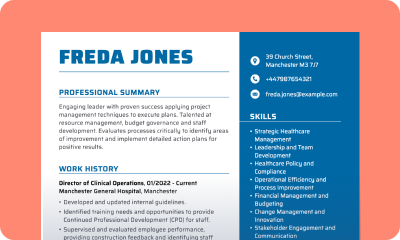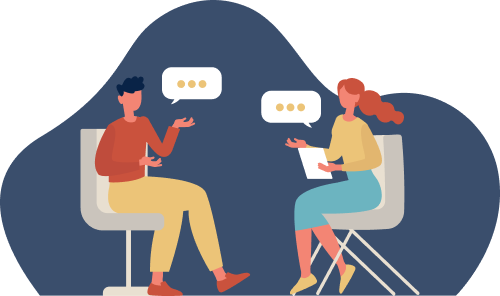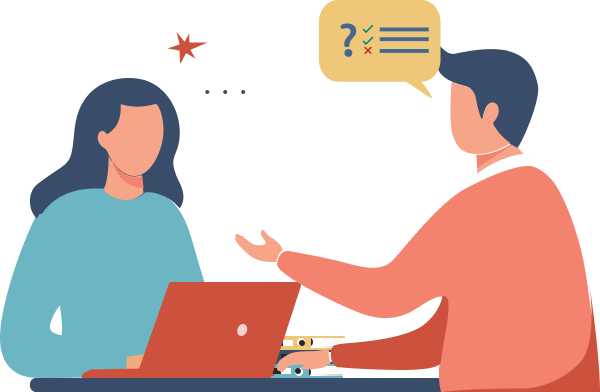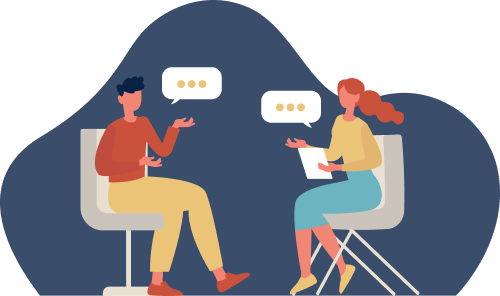How AI Recruitment Is Changing the Job Market
AI recruitment is transforming the way companies hire. In its simplest form, AI recruitment uses artificial intelligence technology to help businesses screen, select, and interview candidates more efficiently than a recruiter ever could.

Our customers have been hired by: *Foot Note
At the heart of it, AI is designed to automate time-consuming tasks, allowing recruiters to focus on decision-making. AI in recruiting already has a myriad of functions, including everything from CV screening to interviewing, even suggesting which candidates may be a good fit based on specific criteria.
In this article, I’ll discuss how AI recruitment works, what tasks it can perform, and how it’s likely to change in the future. I’ll also give you valuable tips on how to become a fitting candidate in the eyes of the AI, without becoming a robot yourself.
The rise of AI recruitment tools
Over the past decade, AI has moved from being a buzzword to a necessity in recruitment. In the past, hiring involved slow, manual processes, weeks of waiting for feedback, and recruiters sifting through stacks of CVs. Today, AI-powered tools like Applicant Tracking Systems (ATS), chatbots, and video interview platforms are transforming how companies find and assess talent.
Depending on where you look, you’ll find different statistics on how many companies utilise AI in their recruitment processes. According to the survey conducted by The Access Group, it’s 68%. The UK government has this value at 48% among just recruitment agencies, which is almost a coin toss chance of being evaluated by an AI.
What’s exciting is that these tools aren’t just making the process quicker; they’re also helping employers make more objective, data-driven decisions. The technology doesn’t get distracted by unconscious bias, which can improve inclusivity in hiring. These tools handle repetitive and time-consuming tasks, like:
1. CV parsing & screening
At the heart of many companies’ hiring processes lie Applicant Tracking Systems (ATS). They are AI-powered tools that help filter, organise, and screen CVs to streamline the hiring process. When you apply for a job, your CV is often put through an ATS before it even reaches a human recruiter. The ATS scans your CV for keywords that match the job description, such as specific job skills, education & degrees, or work experience.
The benefits of ATS are clear—they save time and effort by automatically sorting through hundreds or thousands of CVs. For employers, this means only the most relevant CVs are passed to the hiring manager.
For job seekers, however, ATS can pose a challenge. If your CV doesn’t align closely with the job description or isn’t formatted in a way the ATS understands, it might not get through to the recruiter.
But not all is lost, as some recruiters also glance at those CVs that were rejected by ATS. I have first-hand experience in getting a job after the ATS deemed me unworthy because I focused on highlighting achievements that weren’t relevant for the job. Still, you don’t want to bet your career on pure luck. It’s much smarter to plan for ATS compatibility straight away.
AI CV builders are becoming a popular way of creating job application documents. Since companies are using AI to evaluate candidates, why shouldn’t candidates use AI to gain an edge as well? Learn how an AI CV can benefit your career journey.
2. Chatbots for candidate engagement
AI-driven chatbots have become a staple of the modern recruitment process, and it’s not hard to see why. These tools engage with candidates in real-time, answering questions, providing information about job roles, and even assisting with application submissions.
They are just like the customer service chatbots you can find on most retail websites. For recruiters, this is an incredibly time-saving solution, reducing the workload associated with repetitive candidate inquiries.
For candidates, chatbots offer immediate, 24/7 communication. They can answer questions about job descriptions or explain the next steps in the application process. These bots make things faster and easier for job seekers. That said, chatbots do have some limitations:
- Complex inquiries: Chatbots can handle basic questions, but when it comes to more complex or nuanced issues, they often fall short.
- Impersonal: While efficient, chatbots lack the human touch that some candidates may prefer in their interaction with employers.
3. Candidate sourcing
AI talent acquisition software is also reshaping outreach. Unlike traditional methods of recruitment, where candidates have to apply and hope for the best, AI-driven tools allow recruiters to actively find and engage with candidates, even those who are not actively job hunting. By analysing LinkedIn profiles and databases, AI can identify potential candidates who meet specific criteria and reach out to them.
These AI tools also help recruiters send personalised messages to candidates, increasing the chances of getting a positive response. The AI system tailors these messages based on the candidate’s qualifications, making them feel more relevant and less like a mass email.
4. AI-powered interviewing
The rise of AI-powered video interviews has changed the way candidates are assessed. These platforms not only allow recruiters to ask pre-set questions but also use AI to analyse candidates’ facial expressions, tone of voice, and word choice to assess their responses. It’s a method that’s efficient and scalable, enabling companies to interview candidates without the need for multiple rounds of in-person meetings.
The advantages of AI-powered interviews are evident:
- Improved efficiency: The AI can instantly assess a candidate’s performance, speeding up the interview process.
- Consistency: Every candidate is judged by the same set of criteria, while human recruiters may prefer differing qualifications.
However, there are drawbacks:
- Potential bias: AI algorithms might still reflect the biases of the data they were trained on, potentially leading to unfair outcomes. People with disabilities or neurodivergent traits may often be penalised for “atypical” behaviour.
- Lack of human connection: While efficient, these interviews may lack the personal touch, which can sometimes be important when assessing a candidate’s true potential.
- Unstandardised human behaviours: The biggest issue with AI analysis of non-verbal cues is that there is no “standard” way to behave. People across different cultures and demographics will naturally understand certain non-verbal behaviours differently from others.
5. Predictive analytics for better selection
Imagine if recruiters had a tool that could predict how well a candidate will perform in a role, even before they’re hired. Well, you don’t have to imagine. That’s the magic of predictive analytics.
By analysing data from past hires, social media profiles, and previous job experiences, AI recruitment software can make data-driven predictions about a candidate’s success in a particular role.
The beauty of this technology is that it offers a data-backed approach to recruitment. By identifying patterns and trends, AI can help recruiters make more informed decisions. For instance, predictive analytics might show that candidates with experience in a certain industry or certain personality traits are more likely to succeed in specific roles.
However, relying too heavily on data can be risky:
- Accuracy: While AI can analyse huge amounts of data, it’s only as good as the data it’s trained on. Bias in data can lead to biased predictions.
- Ethical concerns: Predictive analytics can sometimes infringe on privacy or create discrimination based on non-essential factors like social media activity.
What’s interesting about AI recruitment tools is that the majority of people are opposed to employers using AI talent acquisition. According to Pew Research, 66% of adults surveyed in the US said they would not want to apply for a job with an employer that used AI to make hiring decisions.
How you can beat AI recruitment software
As AI continues to shape recruitment processes, every candidate has to adapt to whatever changes AI recruitment tools bring. While they provide many benefits for both employers and candidates, they can also present challenges. Here’s how you can make sure your CV, online presence, and interview responses pass the various AI recruitment hurdles.
1. Optimise your CV for ATS
Applicant Tracking Systems (ATS) are designed to filter CVs based on keywords, skills, and formatting. For job seekers, this means optimising your CV for ATS is crucial. Here’s how to ensure your CV gets past these filters:
- Use the Right Keywords: Carefully read the job description and tailor your CV by including the same keywords and skills mentioned in the ad. Use the exact terms for skills, qualifications, and job titles that the ATS is likely to search for.
- Avoid Complex Formatting: ATS is infamous for its struggles with images, tables, or unconventional fonts. Stick to a simple layout with clear headings, bullet points, and standard CV fonts like Arial or Times New Roman.
- Highlight Relevant Skills and Experience: Ensure that your most relevant work experience and skills section are easily identifiable. List your achievements in order of relevance, with key accomplishments near the top to increase visibility.
By following these tips, your CV is more likely to get through the ATS filter and into the hands of the hiring manager.
2. Master video interviewing with AI
AI-powered video interviews are becoming more common, and they offer recruiters a way to assess candidates based on facial expressions, tone of voice, and responses to pre-recorded questions. To excel in these interviews, job seekers should:
- Speak Clearly and Confidently: Make sure you’re speaking in a clear, concise manner. Avoid rushing your answers. Take a deep breath, and answer each question thoughtfully.
- Maintain Eye Contact and Engage with the Camera: Since AI tools often use facial recognition and other visual cues, eye contact is important. Look directly into the camera as though you’re speaking with a person, and show enthusiasm through your expressions.
- Prepare for Pre-recorded Questions: AI-driven interviews may give you a set of pre-recorded questions to answer. Take your time to structure your responses in a way that highlights your key skills and achievements. If you’re asked a question about problem-solving, share an example from your past job, highlighting how you tackled a challenge and what the outcome was.
3. Enhance your digital footprint
AI talent acquisition tools don’t just look at your CV and interview answers, it can also analyse your digital footprint to evaluate your professional presence. Here’s how you can improve your online visibility to make sure you’re putting your best foot forward:
- Optimise Your LinkedIn Profile: LinkedIn is often one of the first places AI recruitment tools look when evaluating candidates. Ensure your profile is complete and professional. Highlight your skills, experience, and achievements, and ask for recommendations to build credibility.
- Engage in Relevant Online Communities: Join professional groups and participate in discussions relevant to your field. This shows AI recruitment tools (and recruiters themselves) that you’re actively engaged and up-to-date with industry trends.
- Consistency Across Platforms: Ensure your personal branding is consistent across LinkedIn, your CV, and other professional platforms. This creates a unified image of you as a candidate and builds trust.

The future of AI recruitment
AI recruitment is here to stay, and its impact on the hiring process will only continue to grow. As technology advances, so too does the potential for AI to transform the recruitment industry. Let’s explore how AI is expected to evolve and the wider impact on the job market.
Advanced candidate matching and personalisation
In the future, AI will become even more sophisticated in matching candidates with jobs that fit their skills, experience, and potential for success. As AI models become more advanced, they will rely on predictive analytics to identify the best candidates by analysing deeper data points beyond just keywords and qualifications.
This deeper intelligence will allow AI to assess soft skills, cultural fit, and long-term potential, ultimately enabling recruiters to find candidates who are not just a good match for the job but will thrive and grow within the company.
Moreover, personalisation will also improve. AI-driven tools will be able to create tailored candidate journeys. From offering personalised recommendations to creating custom-tailored job suggestions, AI will enhance the candidate experience by guiding them towards roles that align with their career ambitions and aspirations. This makes the recruitment process feel more personal and candidate-centric, addressing their long-term career goals.
More inclusive talent pool through remote and global hiring
AI is also going to help companies find and hire talent beyond geographical boundaries. With the rise of remote work and AI-enabled recruitment tools, recruiters will have access to a global talent pool. AI recruitment systems will help assess candidates from different countries, with a focus on skills, experience, and cultural adaptability, instead of just their location or work history in one region.
This shift will make it easier for businesses to attract and hire diverse talent from all over the world, without limitations. It will allow companies to tap into underrepresented regions and hidden talent pools, increasing their chances of finding the best candidates, regardless of where they are located. AI will further help match candidates to roles that fit their skills and ambitions, no matter where they are based.
Bias reduction and ethical AI
A major evolution in AI talent acquisition will be its ability to identify and reduce bias in the recruitment process. As AI algorithms become more refined, we will see improved data processing and adjustments to algorithms that ensure they make decisions based on merit rather than subjective factors.
For example, AI tools will be able to continuously monitor their own decision-making processes and adapt over time to eliminate discriminatory practices based on gender, ethnicity, or age. Bias reduction will not only help in achieving a more inclusive hiring process but will also make recruitment fairer for everyone.
Furthermore, AI will be used to make hiring decisions more transparent. In the future, explainable AI (XAI) will allow candidates to understand why they were selected or rejected for a role, creating a sense of trust and clarity in the process.
AI-driven career coaching and mentorship
AI’s role won’t just be limited to hiring. As it evolves, AI will start providing career advice and personal development support, helping employees throughout their professional journey. AI will be used to analyse an individual’s performance data, career goals, and aspirations, and then provide personalised recommendations on how to improve skills, earn certifications, and navigate their career path.
By tracking progress, AI systems will help individuals take proactive steps to advance in their careers. It may also offer targeted learning opportunities to help candidates stay ahead of industry trends, making them more adaptable and employable.
AI’s future impact on the job market
The influence of AI on the job market is no longer just theoretical. While I already discussed it in the context of recruitment, its reach extends far beyond the hiring process. AI is actively shaping the job market, altering how companies recruit, how people apply for roles, and even how the skills needed to succeed in the workplace are evolving.
Creation of new job categories
With AI’s growing presence, new roles are emerging that never existed before. These job categories are directly tied to the technology, as well as the need for human oversight and expertise. For instance:
- AI Trainers: Machines, like people, need to be taught. AI trainers will be responsible for teaching AI systems how to interpret data, assess candidates, and make decisions based on certain criteria.
- Bias Auditors: Given the concerns around AI perpetuating bias, this new role will focus on ensuring that AI-driven recruitment tools are fair and inclusive, and don’t inadvertently exclude diverse talent.
- Data Interpreters and AI Ethicists: With more reliance on data, AI ethicists will help regulate how data is used, ensuring it’s done responsibly and transparently. These professionals will also help mitigate ethical concerns around privacy, bias, and fairness.
Blending of human intuition and AI efficiency
AI recruitment software is incredibly efficient at analysing vast amounts of data and streamlining hiring processes. However, human intuition will remain an irreplaceable part of recruitment and the wider job market.
- Humans Know Context: While AI can be superb at matching candidates based on data points, it doesn’t always understand context or nuances in a candidate’s background. Human recruiters can read between the lines and assess cultural fit, motivation, and soft skills.
- AI and Humans Working Together: We’ll see a hybrid model where AI systems support human decision-making, but humans still make the final judgement on candidates, bringing in their personal experience and intuition to guide the hiring decision.
Shifting skill requirements and job creation
As AI takes over repetitive and manual tasks, the types of skills needed in the workforce are changing. There’s a growing demand for advanced hard, technical skills, creativity and empathy—qualities that AI cannot replicate—are becoming more valuable.
The rise of AI-powered job tools means that workers need to stay relevant by constantly updating their skills. As automation takes over certain roles, workers will need to learn new technologies and improve their adaptability to keep up with changing job requirements.
Automation and job displacement
Despite the many benefits of AI, one of the more challenging impacts is the potential for job displacement. AI can replace repetitive, manual jobs, especially in sectors like manufacturing, customer service, and administrative roles.
AI may lead to the rise of a gig economy, where people are hired for short-term projects rather than permanent roles. This shift will mean workers need to be more self-reliant, entrepreneurial, and skilled at navigating fluctuating job opportunities.
Key Takeaways
- AI tools are revolutionising recruitment, making candidate screening faster and more efficient.
- Job seekers can optimise their CVs to pass ATS filters, highlight soft skills, and prepare for AI-powered video interviews.
- The rise of AI recruitment tools will continue to reduce bias, improve candidate matching, and expand global talent pools.
- AI is making the recruitment process faster, fairer, and more inclusive, helping businesses find the best candidates, regardless of location or background.
- The future of hiring will be driven by AI’s ability to provide a more personalised, efficient, and diverse recruitment process.

Mariusz Wawrzyniak
Content Writer
Mariusz is a career expert at MyPerfectCV who writes practical, research-based guides that help professionals from all industries craft impactful CVs, write compelling cover letters, and advance their careers.
*The names and logos of the companies referred to above are all trademarks of their respective holders. Unless specifically stated otherwise, such references are not intended to imply any affiliation or association with myperfectCV.










